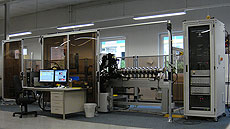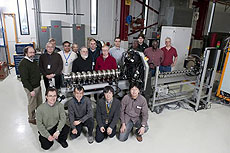Fine-tuning the instruments of acceleration

Two of the four recently built tuning machines are at DESY. The customized enclosure is a safety feature.

Some members of the automatic cavity tuning machine international collaboration. Front row, from left: Ruben Carcagno, Fermilab; Toshio Sishido, Hotishi Hayano and Ken Watanabe, KEK. Back row, from left: Guennadi Kreps, DESY; Roger Nehring, Sergey Kotelnikov, Dileep Bhogadi, Andrzej Makulski, Bill Mumper and Jerzy Nogiec, Fermilab; Jan-Hendrik Thie, DESY; Cosmore Sylvester, Fermilab; Alessandro Quadrelli, University of Pisa student; Fred Lewis and Warren Schappert, Fermilab.
Achieving resonance in a scientific collaboration is no small feat, but scientists at Fermilab, DESY and KEK have come together to do exactly that: They've improved the mechanism that keeps superconducting radio frequency cavities in tune.
Members of Fermilab's Technical Division and DESY staff, with financial assistance from KEK, recently built four new tuning machines that set SRF cavities to the correct frequency and alignment. More highly automated than their predecessors, the machines save time and labor and ensure greater consistency in RF cavity quality. They work by squeezing or stretching individual cells in a nine-cell cavity and allowing all of them to perform identically and impart the same acceleration to the beam.
"Now we don't need RF experts to tune them one by one," said Technical Division Head Giorgio Apollinari. "We can put them in a machine, push a button, and let it run."
The teams engineered the new machines with DESY's future X-ray Free-Electron Laser in mind, as well as the proposed Project X and International Linear Collider. If scientists were to build the ILC, it would need 18,000 SRF cavities, all of which would require tuning.
"You cannot conceive of doing this by hand," Apollinari said.
Under the technical direction of electrical engineer Andrzej Makulski and software architect Jerzy Nogiec, Fermilab TD staff developed a complete set of control electronics and control software for the tuning machines. In Germany, DESY staff developed the mechanical assembly and electrical devices.
"Now you need to bring these several pieces together and make it work as one whole unit," said Test and Instrumentation Department Head Ruben Carcagno, who led Fermilab's part in the collaboration. "You have to have good team coordination so that when you bring everything together it works."
By seamlessly integrating their respective contributions, the teams built a machine that would allow a non-RF expert to tune and align a nine-cell cavity in four hours. Because two machines will operate in European industry, they also had to incorporate certain design features to comply with stringent European safety standards.
Two of the tuning machines are now at DESY. One has shipped to KEK and one remains at Fermilab.
"You hear about the perfect storm," Apollinari said. "This was a perfect collaboration, one that really makes you look forward to future collaborative work."
--- Leah Hesla
|
|